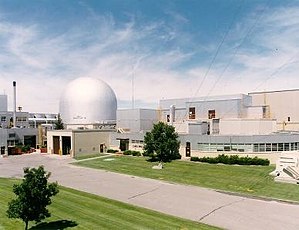مفاعل سريع متكامل

مفاعل سريع متكامل هو تصميم لمفاعل نووي يستخدم نيوترونات سريعة ولا يوجد وسيط نيوتروني.[1]
حيث يولد المفاعل السريع المتكامل مزيد من الوقود ويتميز بدورة وقود نووي تستخدم إعادة المعالجة عن طريق التصفية الإلكترونية في موقع المفاعل.[2]
نبذة[عدل]
بدأ تطوير مفاعل سريع متكامل في عام 1984 وبنت وزارة الطاقة الأمريكية نموذج أولي وهو المفاعل النووي التجريبي الثاني.[3] في 3 أبريل 1986 أظهر اختباران للسلامة لمفهوم امفاعل سريع متكامل هذه الاختبارات كانت عبارة عن محاكاة الحوادث التي تنطوي على فقدان تدفق المبرد حتى مع تعطيل أجهزة الإغلاق العادية ويقوم المفاعل بإغلاق نفسه بأمان دون زيادة الحرارة في أي مكان في النظام. تم إلغاء مشروع مفاعل سريع متكامل من قبل الكونغرس الأمريكي في عام 1994.[4]
المراجع[عدل]
- ^ "GE Hitachi Nuclear Energy Encourages Congress to Support Development of Recycling Technology to Turn Used Nuclear Fuel into an Asset - GE Energy press release". Genewscenter.com. 2009-06-18. Archived from the original on 2013-12-03. Retrieved 2014-01-24.
- ^ Radioactivity and its associated dangers are roughly divided by an isotope's half-life. For example, Technetium-99's 213,000 year half-life combines with the IFR's 1/20 volume reduction to produce about 1/4,000,000 of the radiotoxicity of light water reactor waste. The small size (about 1.5 tonnes per gigawatt-year) permits expensive disposal methods such as insoluble synthetic rock. The hazards are far less than those from fossil fuel wastes or dam failures.
- ^ Warner, Ethan S.; Heath, Garvin A. Life Cycle Greenhouse Gas Emissions of Nuclear Electricity Generation: Systematic Review and Harmonization, Journal of Industrial Ecology, Yale University, published online April 17, 2012, doi:10.1111/j.1530-9290.2012.00472.x
- ^ Milsted, J.; Friedman, A. M.; Stevens, C. M. (1965). "The alpha half-life of berkelium-247; a new long-lived isomer of berkelium-248". Nuclear Physics. 71 (2): 299. Bibcode:1965NucPh..71..299M. doi:10.1016/0029-5582(65)90719-4. "The isotopic analyses disclosed a species of mass 248 in constant abundance in three samples analysed over a period of about 10 months. This was ascribed to an isomer of Bk248 with a half-life greater than 9 y. No growth of Cf248 was detected, and a lower limit for the β− half-life can be set at about 104 y. No alpha activity attributable to the new isomer has been detected; the alpha half-life is probably greater than 300 y."
